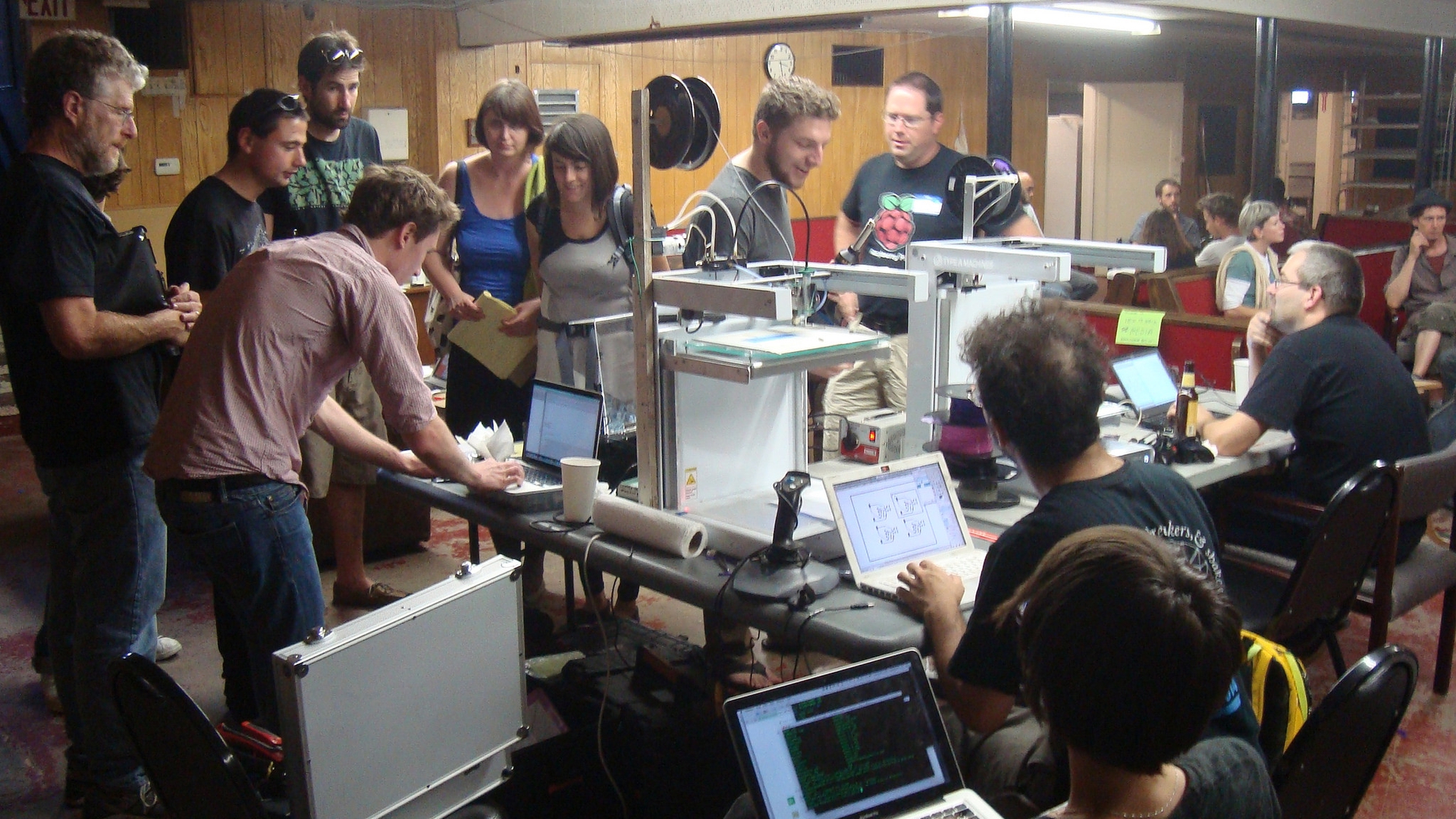Disrupting Disruption: On Intervening Against Technological Restructuring
by
R.K. Upadhya
March 30, 2018
Featured in Technology and The Worker (#2)
Strategies for class struggle must include organizing at the sites of techno-scientific research and development.
theory
Disrupting Disruption: On Intervening Against Technological Restructuring
by
R.K. Upadhya
/
March 30, 2018
in
Technology and The Worker
(#2)
Strategies for class struggle must include organizing at the sites of techno-scientific research and development.
In the introduction to General Intellects, McKenzie Wark makes a provocative point about a blindspot in Marx’s analysis on science and technology. Wark focuses on Marx’s Fragment on Machines, a set of notes that speculate that technological development is essentially the transferring of skills and knowledge of workers into machines in a process mediated by and for the interests of capital. However, there is a gap here in terms of the actual process of how this information is turned into machinery in the first place.
For Marx, science will appear to the laborer as something alien to him. Science appears in the form capital dictates. Science is a productive force: “all the sciences have been pressed into the service of capital”. But who makes science? “Invention has become a business,” says Marx, but who does the inventing?…
…The problem is that as actual organized social activities, science and technology do not fit so neatly into the schema of labor and capital. Hence in Marx they simply come from without as a reified thing called “science” which then becomes part of the machine system as fixed capital. (8-9)
Indeed, one could argue that this blindspot constitutes a kind of fetishization of science and technology, in the same fashion that (as Marx argued) capitalism generates a fetishization of commodities, where the social relations bound up in their production are masked from consumers. Likewise, the specific processes behind the transformation of worker knowledge into technology are overlooked. What do these processes actually look like? And who does science and engineering in the first place, and what is their relationship to class struggle?
This same type of fetishization has largely persisted into contemporary Marxism, including those currents which center class composition.
The framework of class composition, developed out of work by militant intellectuals in Italy in the 1960s, carries forward Marx’s arguments in Fragment to help understand the dialectic between class struggle and technology, arguing that the two are locked together in a feedback loop. Capital’s process of subsuming workers’ knowledge and skills into machines is driven by successful workers’ struggles that decrease the rate of profit, thus requiring investments into technology, the restructuring of the workplace, and the displacement of workers’ movements as the very nature of work is transformed, displaced, and shifted – a decomposition of the working class. At the same time, this technological restructuring creates new forms of work that create the grounds for new forms of organizing, resistance, and rebellion – a recomposition of the working class. Thus are the two forces – class struggle and technological change – continually driving each other in an escalating spiral, with the composition of workers’ movements continuously transforming.
We’ve seen this process play out in waves throughout the history of capitalism, particularly in its leading edges. Textile workers struggled continuously over the course of the 1800s, while capitalists deployed increasingly sophisticated systems of machinery to combat them – spinning mules, power looms, etc. The rise of the auto industry and Fordism restructured capitalism and undermined the power of the various crafts unions and councils that had sprung up in the late 1800s and early 1900s, but simultaneously laid the grounds for new struggles around the assembly line that gave rise to trade unions and mass communist parties. The restructuring of capitalism in the 1970s and 1980s was partially triggered by the increasing militancy of trade unions, which provoked not just automation, but also new transportation and communication technologies that made possible the offshoring of entire industries away from centers of organized labor.
Class composition theory thus advances Marxist analysis of technology, but continues Marx’s blindspot in brushing aside how technoscience is actually developed for use by capital, and fetishizes technology as an external object that is seemingly spontaneously conjured up by capital.
But if capital’s ultimate weapon against the working class is decomposition through technological restructuring, then it is necessary to analyze the dynamics around technoscientific development such that working-class militants can predict and outflank capital. Without this level of analysis, it is impossible to wage effective class struggle, as militants will always be analyzing class composition and recomposing political organizations after the fact. Anticipating structural changes in response to working class movements, and organizing accordingly, must be a key strategic plank of revolutionary class struggle.
And to raise the stakes even further, there is also a need to strategize around seizing control of the means of technoscientific development, in the same manner as the history of class struggle thus far has been to strategize around seizing the means of production. This more ambitious goal gets back to the idea that the sites of producing science and technology are themselves sites of class struggle. And more than that, whether or not technoscientific workers – programmers, engineers, designers, chemists, biologists, etc. – can be composed into a revolutionary class movement is a question that will also determine whether the process of technological restructuring can itself be seized and turned against capitalism.
Thus, a key task for Marxism and class composition theory today is to recognize that the development of technoscience itself constitutes a terrain of class struggle, where workers of various sorts are mobilized by capital to research, develop, deploy, and maintain its weapons – and where workers of all sorts resist and rebel.
This line of analysis is not new. One particularly fascinating example of an attempted intervention into technological restructuring occurred right at the start of the postwar era. In 1949, an MIT professor wrote a letter to the president of the United Auto Workers (UAW), warning him of the catastrophic consequences that automation would have on the livelihoods of auto workers, and the need to be proactive. This was not the idle theoretical musing of a crank; the professor in question was none other than Norbert Wiener, widely considered to be the father of cybernetics, who himself was researching and developing the automation technologies in question. Being at the leading edge of capital’s weaponization of technoscience, Wiener was able to fully grasp the future impact of automation on the auto industry and the coming decomposition of worker power in the automobile industry.
To oppose capital’s interests in decomposing worker power, Wiener proposed an alternative scenario where the UAW would surge ahead of technological restructuring and seize control of this process on their own terms:
What I am proposing is this. First, that you show a sufficient interest in the very pressing menace of the large-scale replacement of labor by machine on the level not of energy, but of judgment, to be willing to formulate a policy towards this problem. In particular, I do not think it would be at all foolish for you to steal a march upon the existing industrial corporations in this matter; and while taking a part in production of such machines to secure the profits in them to an organization dedicated to the benefit of labor. It may be on the other hand, that you think the complete suppresion (sic) of these ideas is in order. In either case, I am willing to back you loyally, and without any demand or request for personal returns in what I consider will be a matter of public policy.
Wiener ultimately failed to motivate the UAW to take the question of technological change seriously, and union leadership across the US over the next few decades readily ceded the right to have a say in the use and deployment of technology, in exchange for (temporarily) more control over basic economic issues like wages and benefits. This, as Wiener predicted, lead to escalating attacks on union power as automation and control technologies advanced in the ‘60s and ‘70s, and a secular decline in unionization rates since.
Wiener was more or less working alone in his attempt to help organized labor arm itself with technology and outflank capital. But he was hardly the last to attempt such a program. In David Noble’s Forces of Production: A Social History of Industrial Automation (1984), a masterpiece in Marxist analysis of technology and its socio-political dimensions, it is revealed how class struggle shaped the formation of automated machine tool technologies that upended the nature of metalworking and undermined the powerful unions in the auto and electrical industries. But also revealed is the potential for an alternative history, where some pro-labor engineers and entrepreneurs attempted to create systems of automation that empowered, rather than undermined, the unions on the shop-floor.
Numeric control – which evolved into computer numeric control (CNC) machines used widely in machining today – was designed and marketed as a way for management to gain control over the skills that were monopolized by skilled machinists on the shop floor, who used their power to defend and advance the interests of the union. NC machines performed the same tasks as the machinists, but required much less skilled workers to operate them, and placed the complex and highly mathematical labor of programming the machines in the hands of engineers who were not unionized and close to management.
In contrast to NC, the Specialmatic sought to preserve the skills and power of the shop-floor machinists. The system was developed by F.P. Caruthers, an electrical controls engineer, who wished to help protect the positions of organized labor. The Specialmatic was designed to enable the machinists themselves to program and modify the machine using a system of plugboards, keys, and dials, thus dispensing with the complex mathematics of NC programming. But maintaining the power of the unionized machinists ran counter to the goals that most companies and managers had around automation; and despite reaching out to the UAW, their response was the same as it was to Wiener. Thus alternative technologies such as the Specialmatic (and others, like record playback control) were left at the wayside, while capital invested in and deployed NC, with devastating consequences for the metalworking unions.
While Wiener and other progressive engineers in the US were generally isolated from power, this was not the case in Chile during the course of an analogous effort to appropriate technology for working class interests: Project Cybersyn. Eden Medina’s in-depth history book Cybernetic Revolutionaries: Technology and Politics in Allende’s Chile (2011) describes how the program, run by socialist engineers and designers, and sponsored by the democratically elected socialist government of Salvador Allende, sought to develop a telecommunications network that would assist in the nationalization and centralization of the economy. But more interestingly, it also sought to design working-class empowerment into the technology, imagining that the network’s main control centers would be run by both workers and managers, and that the data collected by the system would be readily available to workers to use as they saw fit, increasing their autonomy and power in the workplace.
The attempt by Project Cybersyn to build a socialist industrial Internet met with mixed results, not least because it was destroyed after a few short years of development due to the 1973 military coup, which overthrew the Allende government and violently dismantled Chile’s democracy. But the project is still a prime example of technological development that, at least in theory, recognized the class character of technology and sought to invert the logic of capitalist technoscience and center, rather than displace, the working class. It also stands in contrast to the use of technology by other 20th-century socialist states, which almost universally mimicked capital’s use of Taylorism and managerial control.
As popular discourse around automation and information technologies today shows, the struggles around systems like CNC and communication infrastructures have not gone away – indeed, they have gotten even more intense.
The rise of digital platforms has restructured numerous labor markets, atomizing workers into competing individuals, and intrusive surveillance technologies has enhanced managerial control over workers across the economy, from warehouses to grocery stores to call centers. Self-driving vehicle systems threatens to unleash an unheard-of level of displacement as it begins to edge into the realm of trucking, which in the US employs over 3 million drivers, and whose routes demand the services of millions more workers. And in other industries where worker organizing has been meeting with increasing success, such as in the food sector, the threat of automated service stations and even automated food processing looms. The profusion of technology in contemporary capitalism means that successful struggles, such as the ongoing campaign for increasing the minimum wage, will almost certainly be met with ruthless mechanization and digitization.
But despite technology being more disruptive than ever before, the potential for radical organizing among technoscientific workers is also at unprecedented levels. Silicon Valley appears to be a potent hot spot: since the 2016 elections in the US, there has been an unprecedented level of visible unrest among workers at all levels in the tech industry, from food service workers to programmers and engineers. Organizations such as the Tech Workers Coalition (TWC) have seen dramatic growth, and other organizations such as the Democratic Socialists of America (DSA) have seen an influx of skilled technical workers. This is an important development, given that most of capital’s dynamism today comes out of the tech industry, whose processes are at the center of data collection, artificial intelligence, and automation.
Thus, the task today is to inquire into these new developments and facilitate the composition of new organs of class struggle in the centers of technoscientific production. In Silicon Valley, this is already taking place, via efforts at self-inquiry and autonomous organization. But these efforts must also penetrate all other sectors and sites of research, development, and deployment: from biotechnology to energy engineering to cognitive science, from major multinational corporations to public universities. Only then can we truly struggle toward breaking the endless cycles of technoscientific restructuring and political recomposition, and the full overthrow of global capitalism.
Featured in Technology and The Worker (#2)
author
R.K. Upadhya
Subscribe to Notes from Below
Subscribe now to Notes from Below, and get our print issues sent to your front door three times a year. For every subscriber, we’re also able to print a load of free copies to hand out in workplaces, neighbourhoods, prisons and picket lines. Can you subscribe now and support us in spreading Marxist ideas in the workplace?
Read next

Perks of the Job
by
Scott Surette
/
March 30, 2018


